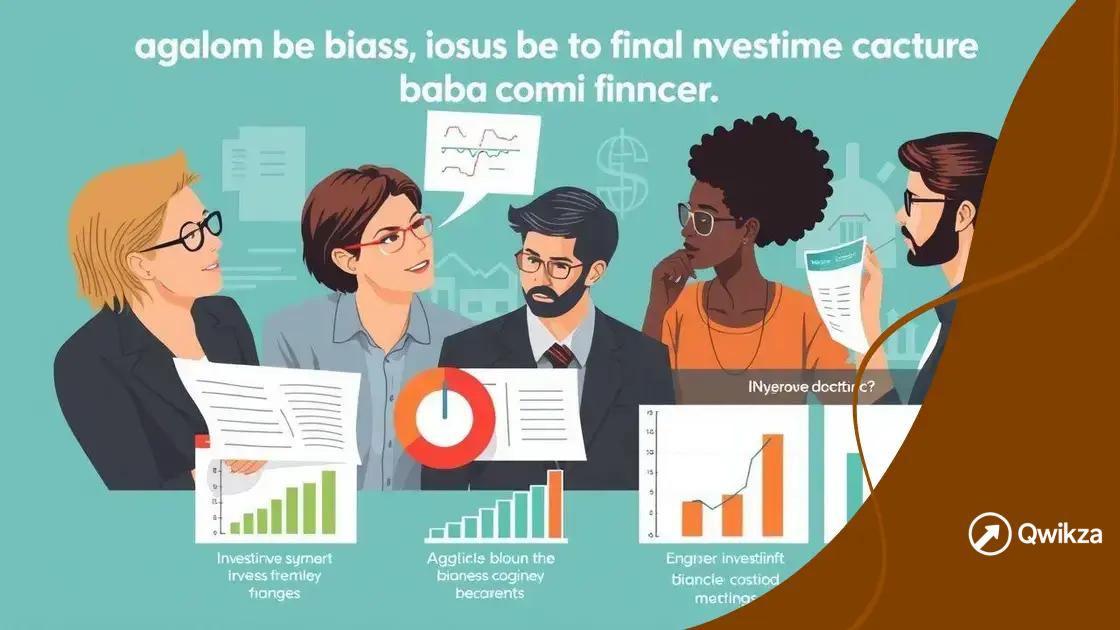Behavioral economics: deciphering financial choices

Behavioral economics examines how psychological factors and cognitive biases influence financial decisions, often leading to irrational behaviors and highlighting the importance of understanding these elements for better money management.
Behavioral economics provides fascinating insights into why people make financial decisions that often defy logic. Have you ever wondered why some choices seem irrational? Let’s explore how psychology plays a significant role in our money matters.
What is behavioral economics?
Behavioral economics is a fascinating field that combines insights from psychology and economics. It examines how people make decisions about their money and resources, often in ways that contradict traditional economic theories. By understanding these irrational behaviors, we can better comprehend the economic choices we make every day.
This branch of economics focuses on the psychological factors that influence financial decisions. For example, people often act on emotions rather than logic when it comes to spending and saving. Behavioral economics uncovers the reasons behind these actions, helping us tailor better financial advice.
Cognitive Biases
Cognitive biases play a vital role in behavioral economics. These are systematic patterns of deviation from norm or rationality in judgment. When making financial decisions, individuals may fall prey to various biases, such as:
- Anchoring: Relying heavily on the first piece of information encountered.
- Loss Aversion: The tendency to prefer avoiding losses rather than acquiring equivalent gains.
- Overconfidence: Excessive confidence in one’s own answers or abilities.
By identifying these biases, we can learn how to avoid them and make more rational decisions. For instance, being aware of loss aversion can encourage individuals to take smart risks rather than shying away from potential beneficial investments.
The Role of Emotions
Another crucial aspect of behavioral economics is the impact of emotions on financial decisions. Emotions can cloud judgment and lead to irrational behavior. When feeling stressed or anxious about money, a person might make impulsive purchases or avoid necessary financial actions altogether.
Recognizing our emotional responses can help us gain control over our financial choices. Strategies such as mindfulness and self-reflection can mitigate the effects of emotional decision-making, allowing for a more balanced approach to finance. For example, taking a moment to assess your feelings before a big purchase can prevent rash actions.
In summary, behavioral economics reveals the complex interplay between psychology and finance. By acknowledging cognitive biases and the influence of emotions, we can enhance our decision-making processes, leading to healthier financial outcomes. Understanding this discipline can empower individuals to make informed choices, ultimately improving their financial well-being.
Key principles shaping financial decisions
Understanding the key principles of behavioral economics is essential for grasping how we make financial decisions. These principles help explain the often irrational choices we make. Let’s take a look at some of these fundamental ideas.
Framing Effect
The framing effect describes how our decisions can be influenced by the way information is presented. For instance, people may react differently to a glass that is “half full” versus a glass that is “half empty,” even though both statements convey the same reality. This principle shows that context matters significantly in decision-making.
When it comes to financial choices, this means that the way options are framed can lead individuals to choose differently depending on whether it emphasizes gains or losses. For example, a marketing campaign that stresses saved money might persuade more customers than one that highlights the cost of living.
Loss Aversion
Loss aversion is a critical concept in behavioral economics. It suggests that losses generally weigh heavier on our minds than equivalent gains. People are more likely to avoid a loss than to pursue a gain. This principle is why many individuals might hold onto losing investments instead of selling them at a loss, which can hinder their overall financial health.
- Understanding loss aversion can help in framing financial decisions.
- It often leads to risk-averse behavior.
- Awareness of this principle can encourage better investment strategies.
This drives home the importance of recognizing our emotional responses to potential losses in order to make balanced financial choices.
Mental Accounting
Mental accounting refers to the different ways individuals categorize their money. People often have separate “accounts” for various purposes, such as savings for vacation versus emergency funds, even though money is interchangeable. This practice can lead to irrational financial behavior, as individuals may make poor decisions based on these mental categories.
For example, someone might splurge from a bonus they received, treating it as “extra money,” despite having high credit card debt. Understanding mental accounting can help individuals take a more integrated view of their finances.
Recognizing these key principles of behavioral economics provides valuable insights into our financial decision-making processes. By applying this understanding, individuals can improve their financial literacy and ultimately make better financial choices.
The impact of cognitive biases

The impact of cognitive biases on decision-making is significant in the field of behavioral economics. Cognitive biases are systematic errors in thinking that affect the choices we make. These biases can lead individuals to make decisions that are not in their best interest, particularly when it comes to financial matters.
Common Cognitive Biases
Some common cognitive biases include:
- Confirmation Bias: This occurs when individuals favor information that confirms their existing beliefs while ignoring evidence that contradicts them.
- Anchoring Bias: People often rely too heavily on the first piece of information they receive when making decisions, which can skew their judgment.
- Overconfidence Bias: Many individuals overestimate their knowledge and ability when making forecasts, which can lead to poor investment choices.
These biases can shape our financial decisions in various ways. For instance, an investor might hold onto a losing stock, convinced it will rebound simply because they have invested time and emotion into it. This illustrates how cognitive biases can distort our view and lead to irrational behaviors.
The Role of Heuristics
Heuristics are mental shortcuts that help people make decisions quickly but can also lead to cognitive biases. When faced with complex financial decisions, individuals may rely on heuristics rather than thorough analysis. For example, an investor might choose a mutual fund based on past performance without considering the full spectrum of data.
This reliance on heuristics can cause people to overlook important details or dismiss valuable alternatives. Recognizing these patterns helps in making more informed financial choices. By understanding the impact of cognitive biases, individuals can become aware of how their thinking might be clouded, allowing for better decision-making strategies.
It is essential to be mindful of our cognitive biases to improve financial literacy. Strategies such as seeking advice from knowledgeable sources and approaching decisions with a critical mindset can mitigate the effects of these biases. By doing so, people can enhance their financial outcomes over time.
Real-life applications of behavioral economics
Real-life applications of behavioral economics are transforming our understanding of finance and decision-making in everyday life. By applying psychological insights, businesses and individuals can improve their financial outcomes and make better choices.
Marketing Strategies
One notable application is in marketing. Companies use principles from behavioral economics to design campaigns that resonate more with consumers. For instance, by understanding the framing effect, marketers can present products in a way that highlights potential gains rather than losses. When customers perceive a positive frame, they are more likely to make a purchase.
Another technique is scarcity marketing. When a product is presented as rare or limited in time, it creates urgency, prompting consumers to act quickly. Here are some effective strategies based on behavioral insights:
- Limited-Time Offers: Promotions that last for a short period can drive immediate actions.
- Social Proof: Showing that others are buying a product can encourage more purchases.
- Defaults: Setting beneficial options as default choices can facilitate favorable decisions.
Personal Finance Tools
Another practical use of behavioral economics is in the development of personal finance tools. Applications that help users budget and track expenses often utilize features that help combat cognitive biases.
For example, some apps gamify saving, making it feel more rewarding and engaging. People may be more likely to save money if they see progress as points or achievements. Additionally, reminders and prompts are designed to counteract procrastination.
Financial advisors also use behavioral insights to guide clients through decision-making processes. Recognizing biases allows advisors to tailor advice that aligns with clients’ behaviors and motivations. This approach can lead to better investment strategies and risk management.
By integrating the principles of behavioral economics into everyday practices, individuals and businesses can make strides toward smarter financial decisions. Whether through effective marketing or personalized finance management, these applications prove that understanding human behavior is key to success.
Strategies to improve financial literacy
Improving financial literacy is crucial for making informed decisions about money. There are several strategies that individuals can use to enhance their understanding of financial concepts and improve their overall financial well-being.
Education and Resources
One effective way to boost financial literacy is through education. Utilizing various resources can help individuals gain valuable knowledge. Here are some effective educational strategies:
- Online Courses: Many platforms offer free or low-cost courses on budgeting, investing, and personal finance.
- Books and Articles: Reading finance-related literature can provide deeper insights into managing money.
- Workshops and Seminars: Attending local workshops can connect individuals with experts in finance.
These resources make learning engaging and are often tailored to different experience levels, ensuring everyone can benefit.
Practical Experiences
Another important aspect of improving financial literacy is gaining practical experience. Applying knowledge in real-life situations can reinforce learning. For example, creating a budget helps individuals see where their money goes each month. This hands-on approach can lead to greater understanding and discipline in spending habits.
Setting up a savings plan is also beneficial. When individuals actively save towards a goal, they learn about interest, investment options, and the importance of emergency funds. Engaging with financial tools and applications can make this process easier and more interactive.
Furthermore, discussing financial topics with family and friends encourages sharing of experiences and ideas. Conversations about saving, spending, and investments reinforce understanding and create a supportive learning environment.
By adopting these strategies to improve financial literacy, individuals can empower themselves to make better financial decisions. As knowledge grows, confidence in managing personal finances also increases, leading to greater financial stability and success.
In conclusion, understanding behavioral economics is essential for improving financial decisions. By recognizing key principles like cognitive biases and emotional influences, individuals can better navigate their financial lives. Strategies such as enhancing financial literacy through education, practical experience, and open discussions are vital in this process. As knowledge grows, so does confidence, leading to smarter financial choices and greater stability. Empower yourself with the tools and insights from behavioral economics to thrive in your financial journey.
FAQ – Frequently Asked Questions about Behavioral Economics
What is behavioral economics?
Behavioral economics studies how psychological factors influence financial decisions, often leading to irrational behaviors.
How can understanding cognitive biases help me?
Recognizing cognitive biases allows you to make more informed and rational financial decisions, avoiding common pitfalls.
What strategies can improve my financial literacy?
You can improve financial literacy by taking online courses, reading books, and discussing financial topics with others.
Why is practical experience important in finance?
Gaining practical experience through budgeting and saving helps reinforce financial concepts and improve money management skills.
